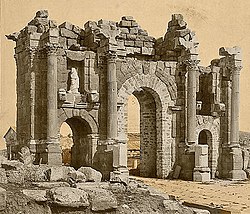 Capitoline Hill of Sufetula | |
| Location | Sbeitla, Tunisia |
|---|---|
| Coordinates | 35°14′25″N9°7′11″E / 35.24028°N 9.11972°E |
| Type | Settlement |
| Part of | |
| Area | 50 ha |
| History | |
| Founded | 67 AD |
| Abandoned | 647 AD |
| Site notes | |
| Excavation dates | 1906-1921 [1] |
The archaeological site of Sbeitla is an archaeological site in Sbeitla, in north-central Tunisia. It represents the Roman ruins of Sufetula, [2] and contains the best preserved Roman forum temples in Tunisia. It was excavated and restored between 1906 and 1921.

